Leadership and Management: Developing Skills and Strategies Report
VerifiedAdded on 2020/06/04
|15
|5506
|45
Report
AI Summary
This report delves into the multifaceted realm of leadership and management, providing a comprehensive analysis of skills, styles, and strategies crucial for organizational success. It begins with an introduction highlighting the significance of managers and leaders in achieving company objectives, setting the stage for an exploration of leadership theories such as the Great Man theory, Trait theory, and Behavioral theory. The report then presents a case study involving Angela, an Associate Director of a non-profit agency, to illustrate practical applications of leadership and management principles. Furthermore, the report discusses essential leadership and management skills, including managing work, problem-solving, and delegation, alongside actionable steps to build staff confidence. It also explores methods for improving leadership skills, such as maintaining effective communication and fostering a positive attitude. Finally, the report examines various leadership styles, including Laissez-Faire, Autocratic, and Participative leadership, providing a well-rounded understanding of leadership dynamics within an organizational context.
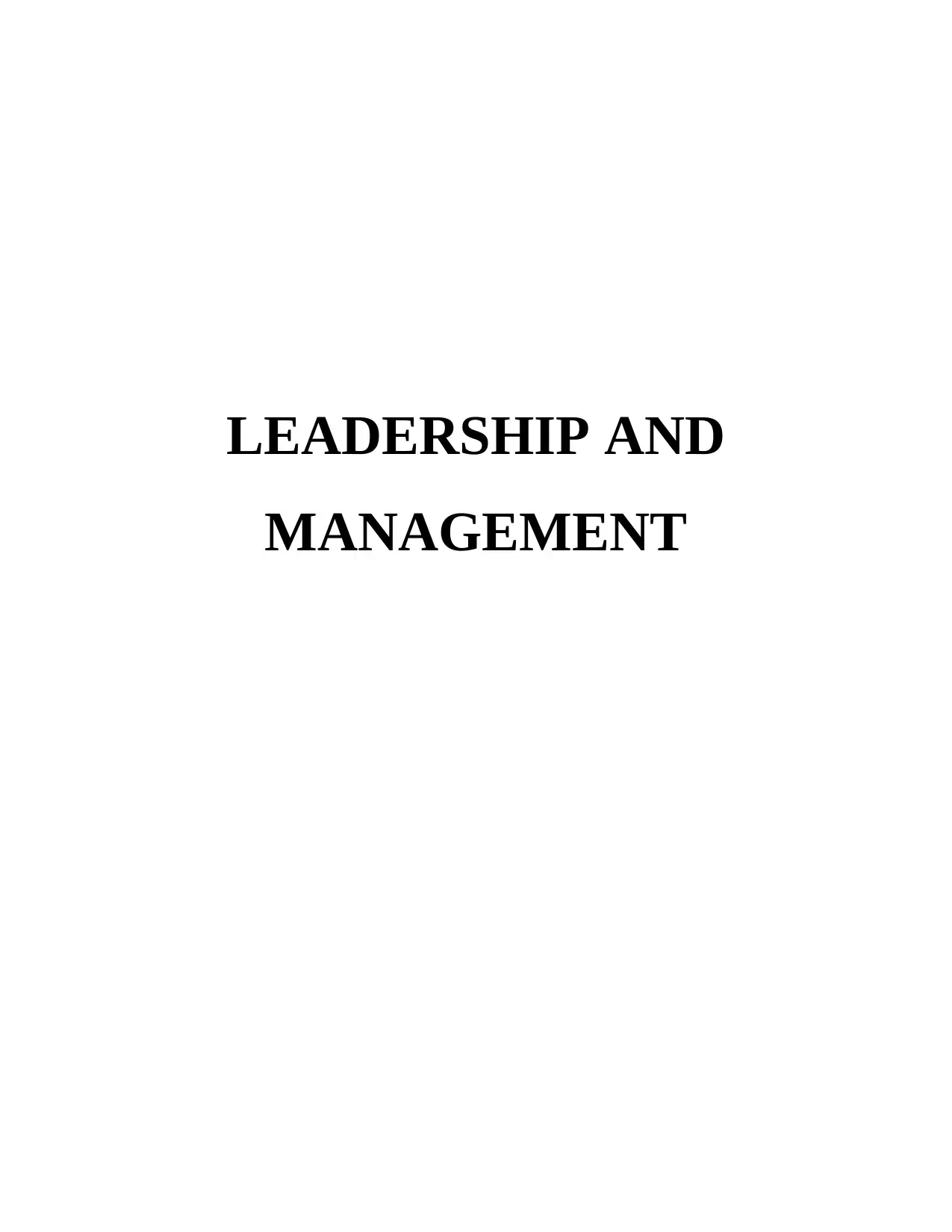
LEADERSHIP AND
MANAGEMENT
MANAGEMENT
Paraphrase This Document
Need a fresh take? Get an instant paraphrase of this document with our AI Paraphraser
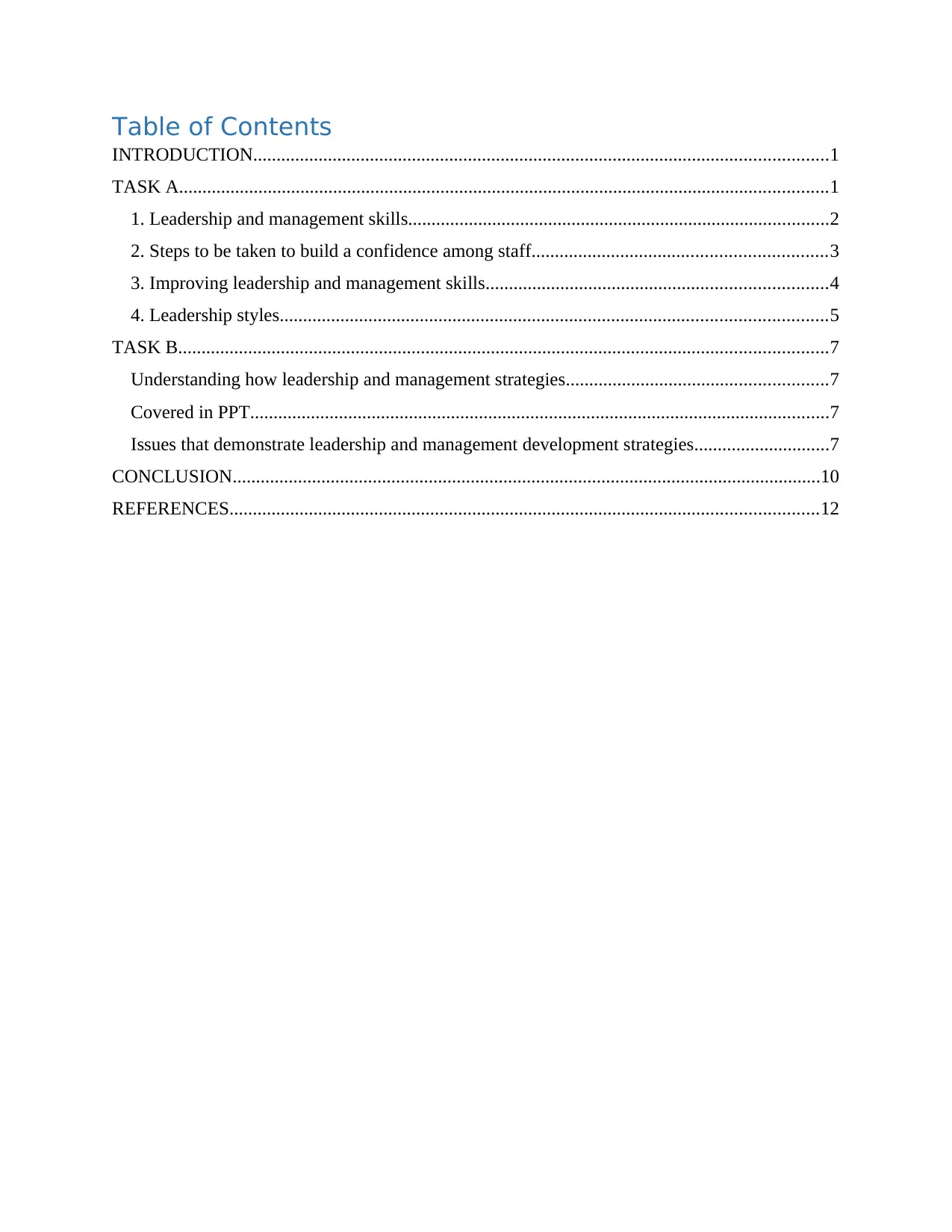
Table of Contents
INTRODUCTION...........................................................................................................................1
TASK A...........................................................................................................................................1
1. Leadership and management skills..........................................................................................2
2. Steps to be taken to build a confidence among staff...............................................................3
3. Improving leadership and management skills.........................................................................4
4. Leadership styles.....................................................................................................................5
TASK B...........................................................................................................................................7
Understanding how leadership and management strategies........................................................7
Covered in PPT............................................................................................................................7
Issues that demonstrate leadership and management development strategies.............................7
CONCLUSION..............................................................................................................................10
REFERENCES..............................................................................................................................12
INTRODUCTION...........................................................................................................................1
TASK A...........................................................................................................................................1
1. Leadership and management skills..........................................................................................2
2. Steps to be taken to build a confidence among staff...............................................................3
3. Improving leadership and management skills.........................................................................4
4. Leadership styles.....................................................................................................................5
TASK B...........................................................................................................................................7
Understanding how leadership and management strategies........................................................7
Covered in PPT............................................................................................................................7
Issues that demonstrate leadership and management development strategies.............................7
CONCLUSION..............................................................................................................................10
REFERENCES..............................................................................................................................12
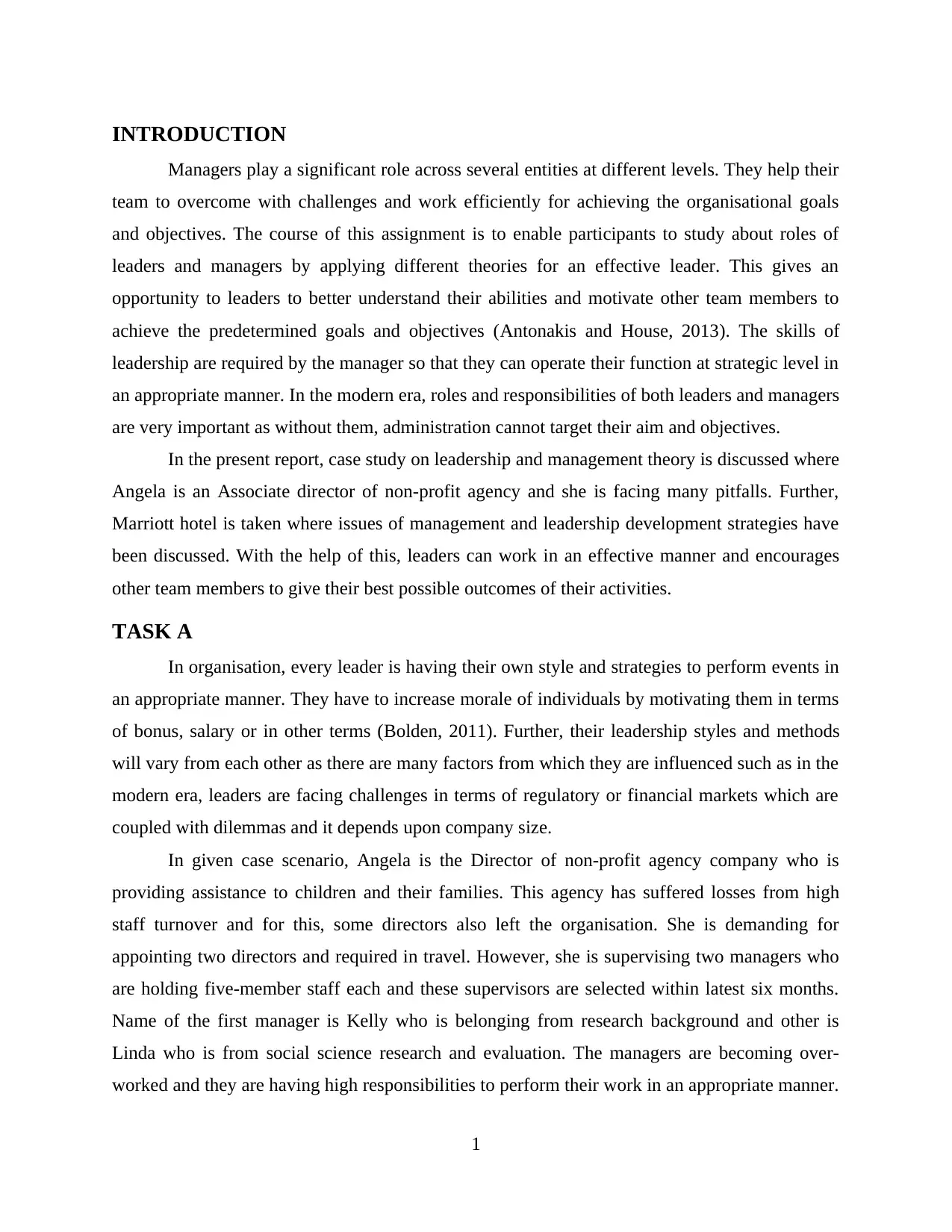
INTRODUCTION
Managers play a significant role across several entities at different levels. They help their
team to overcome with challenges and work efficiently for achieving the organisational goals
and objectives. The course of this assignment is to enable participants to study about roles of
leaders and managers by applying different theories for an effective leader. This gives an
opportunity to leaders to better understand their abilities and motivate other team members to
achieve the predetermined goals and objectives (Antonakis and House, 2013). The skills of
leadership are required by the manager so that they can operate their function at strategic level in
an appropriate manner. In the modern era, roles and responsibilities of both leaders and managers
are very important as without them, administration cannot target their aim and objectives.
In the present report, case study on leadership and management theory is discussed where
Angela is an Associate director of non-profit agency and she is facing many pitfalls. Further,
Marriott hotel is taken where issues of management and leadership development strategies have
been discussed. With the help of this, leaders can work in an effective manner and encourages
other team members to give their best possible outcomes of their activities.
TASK A
In organisation, every leader is having their own style and strategies to perform events in
an appropriate manner. They have to increase morale of individuals by motivating them in terms
of bonus, salary or in other terms (Bolden, 2011). Further, their leadership styles and methods
will vary from each other as there are many factors from which they are influenced such as in the
modern era, leaders are facing challenges in terms of regulatory or financial markets which are
coupled with dilemmas and it depends upon company size.
In given case scenario, Angela is the Director of non-profit agency company who is
providing assistance to children and their families. This agency has suffered losses from high
staff turnover and for this, some directors also left the organisation. She is demanding for
appointing two directors and required in travel. However, she is supervising two managers who
are holding five-member staff each and these supervisors are selected within latest six months.
Name of the first manager is Kelly who is belonging from research background and other is
Linda who is from social science research and evaluation. The managers are becoming over-
worked and they are having high responsibilities to perform their work in an appropriate manner.
1
Managers play a significant role across several entities at different levels. They help their
team to overcome with challenges and work efficiently for achieving the organisational goals
and objectives. The course of this assignment is to enable participants to study about roles of
leaders and managers by applying different theories for an effective leader. This gives an
opportunity to leaders to better understand their abilities and motivate other team members to
achieve the predetermined goals and objectives (Antonakis and House, 2013). The skills of
leadership are required by the manager so that they can operate their function at strategic level in
an appropriate manner. In the modern era, roles and responsibilities of both leaders and managers
are very important as without them, administration cannot target their aim and objectives.
In the present report, case study on leadership and management theory is discussed where
Angela is an Associate director of non-profit agency and she is facing many pitfalls. Further,
Marriott hotel is taken where issues of management and leadership development strategies have
been discussed. With the help of this, leaders can work in an effective manner and encourages
other team members to give their best possible outcomes of their activities.
TASK A
In organisation, every leader is having their own style and strategies to perform events in
an appropriate manner. They have to increase morale of individuals by motivating them in terms
of bonus, salary or in other terms (Bolden, 2011). Further, their leadership styles and methods
will vary from each other as there are many factors from which they are influenced such as in the
modern era, leaders are facing challenges in terms of regulatory or financial markets which are
coupled with dilemmas and it depends upon company size.
In given case scenario, Angela is the Director of non-profit agency company who is
providing assistance to children and their families. This agency has suffered losses from high
staff turnover and for this, some directors also left the organisation. She is demanding for
appointing two directors and required in travel. However, she is supervising two managers who
are holding five-member staff each and these supervisors are selected within latest six months.
Name of the first manager is Kelly who is belonging from research background and other is
Linda who is from social science research and evaluation. The managers are becoming over-
worked and they are having high responsibilities to perform their work in an appropriate manner.
1
⊘ This is a preview!⊘
Do you want full access?
Subscribe today to unlock all pages.

Trusted by 1+ million students worldwide
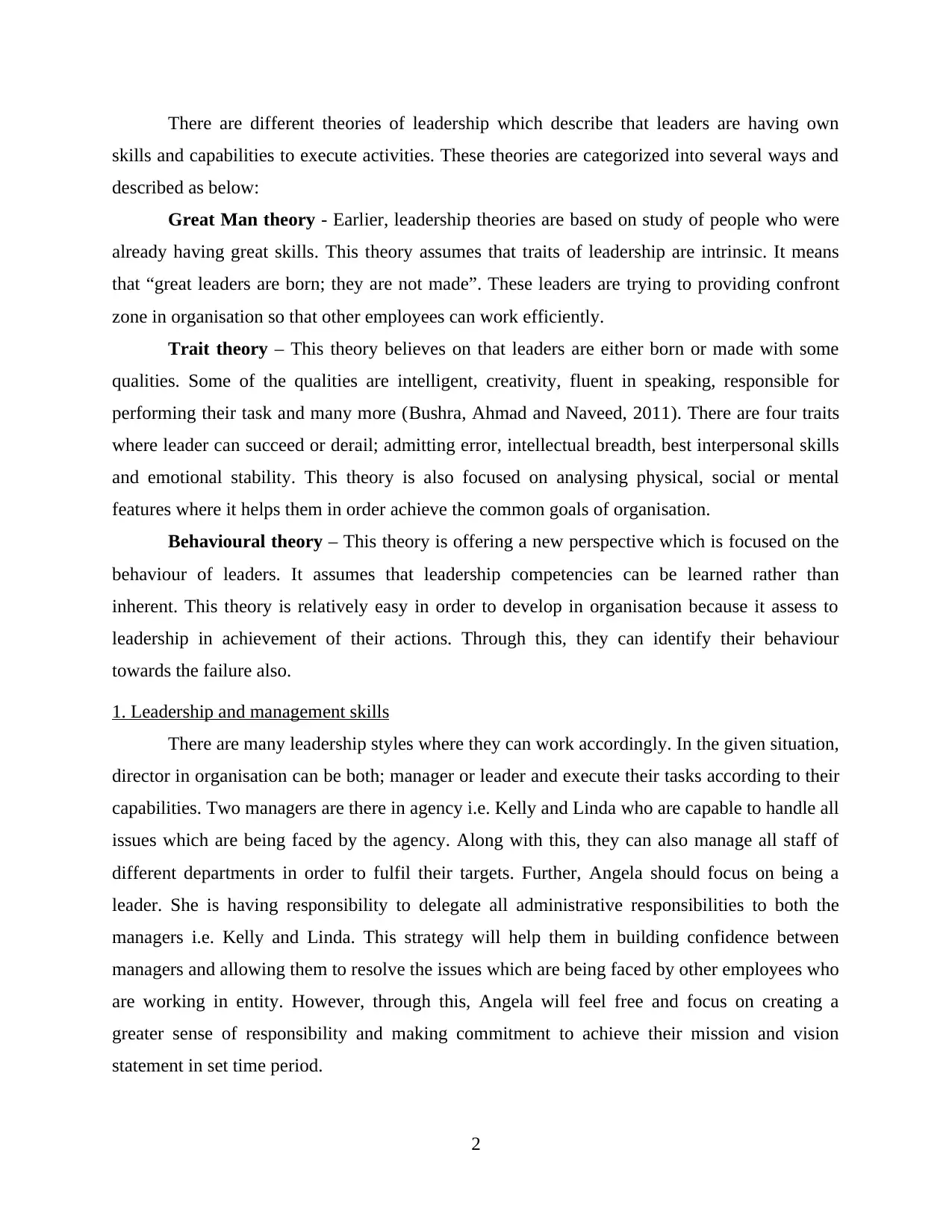
There are different theories of leadership which describe that leaders are having own
skills and capabilities to execute activities. These theories are categorized into several ways and
described as below:
Great Man theory - Earlier, leadership theories are based on study of people who were
already having great skills. This theory assumes that traits of leadership are intrinsic. It means
that “great leaders are born; they are not made”. These leaders are trying to providing confront
zone in organisation so that other employees can work efficiently.
Trait theory – This theory believes on that leaders are either born or made with some
qualities. Some of the qualities are intelligent, creativity, fluent in speaking, responsible for
performing their task and many more (Bushra, Ahmad and Naveed, 2011). There are four traits
where leader can succeed or derail; admitting error, intellectual breadth, best interpersonal skills
and emotional stability. This theory is also focused on analysing physical, social or mental
features where it helps them in order achieve the common goals of organisation.
Behavioural theory – This theory is offering a new perspective which is focused on the
behaviour of leaders. It assumes that leadership competencies can be learned rather than
inherent. This theory is relatively easy in order to develop in organisation because it assess to
leadership in achievement of their actions. Through this, they can identify their behaviour
towards the failure also.
1. Leadership and management skills
There are many leadership styles where they can work accordingly. In the given situation,
director in organisation can be both; manager or leader and execute their tasks according to their
capabilities. Two managers are there in agency i.e. Kelly and Linda who are capable to handle all
issues which are being faced by the agency. Along with this, they can also manage all staff of
different departments in order to fulfil their targets. Further, Angela should focus on being a
leader. She is having responsibility to delegate all administrative responsibilities to both the
managers i.e. Kelly and Linda. This strategy will help them in building confidence between
managers and allowing them to resolve the issues which are being faced by other employees who
are working in entity. However, through this, Angela will feel free and focus on creating a
greater sense of responsibility and making commitment to achieve their mission and vision
statement in set time period.
2
skills and capabilities to execute activities. These theories are categorized into several ways and
described as below:
Great Man theory - Earlier, leadership theories are based on study of people who were
already having great skills. This theory assumes that traits of leadership are intrinsic. It means
that “great leaders are born; they are not made”. These leaders are trying to providing confront
zone in organisation so that other employees can work efficiently.
Trait theory – This theory believes on that leaders are either born or made with some
qualities. Some of the qualities are intelligent, creativity, fluent in speaking, responsible for
performing their task and many more (Bushra, Ahmad and Naveed, 2011). There are four traits
where leader can succeed or derail; admitting error, intellectual breadth, best interpersonal skills
and emotional stability. This theory is also focused on analysing physical, social or mental
features where it helps them in order achieve the common goals of organisation.
Behavioural theory – This theory is offering a new perspective which is focused on the
behaviour of leaders. It assumes that leadership competencies can be learned rather than
inherent. This theory is relatively easy in order to develop in organisation because it assess to
leadership in achievement of their actions. Through this, they can identify their behaviour
towards the failure also.
1. Leadership and management skills
There are many leadership styles where they can work accordingly. In the given situation,
director in organisation can be both; manager or leader and execute their tasks according to their
capabilities. Two managers are there in agency i.e. Kelly and Linda who are capable to handle all
issues which are being faced by the agency. Along with this, they can also manage all staff of
different departments in order to fulfil their targets. Further, Angela should focus on being a
leader. She is having responsibility to delegate all administrative responsibilities to both the
managers i.e. Kelly and Linda. This strategy will help them in building confidence between
managers and allowing them to resolve the issues which are being faced by other employees who
are working in entity. However, through this, Angela will feel free and focus on creating a
greater sense of responsibility and making commitment to achieve their mission and vision
statement in set time period.
2
Paraphrase This Document
Need a fresh take? Get an instant paraphrase of this document with our AI Paraphraser
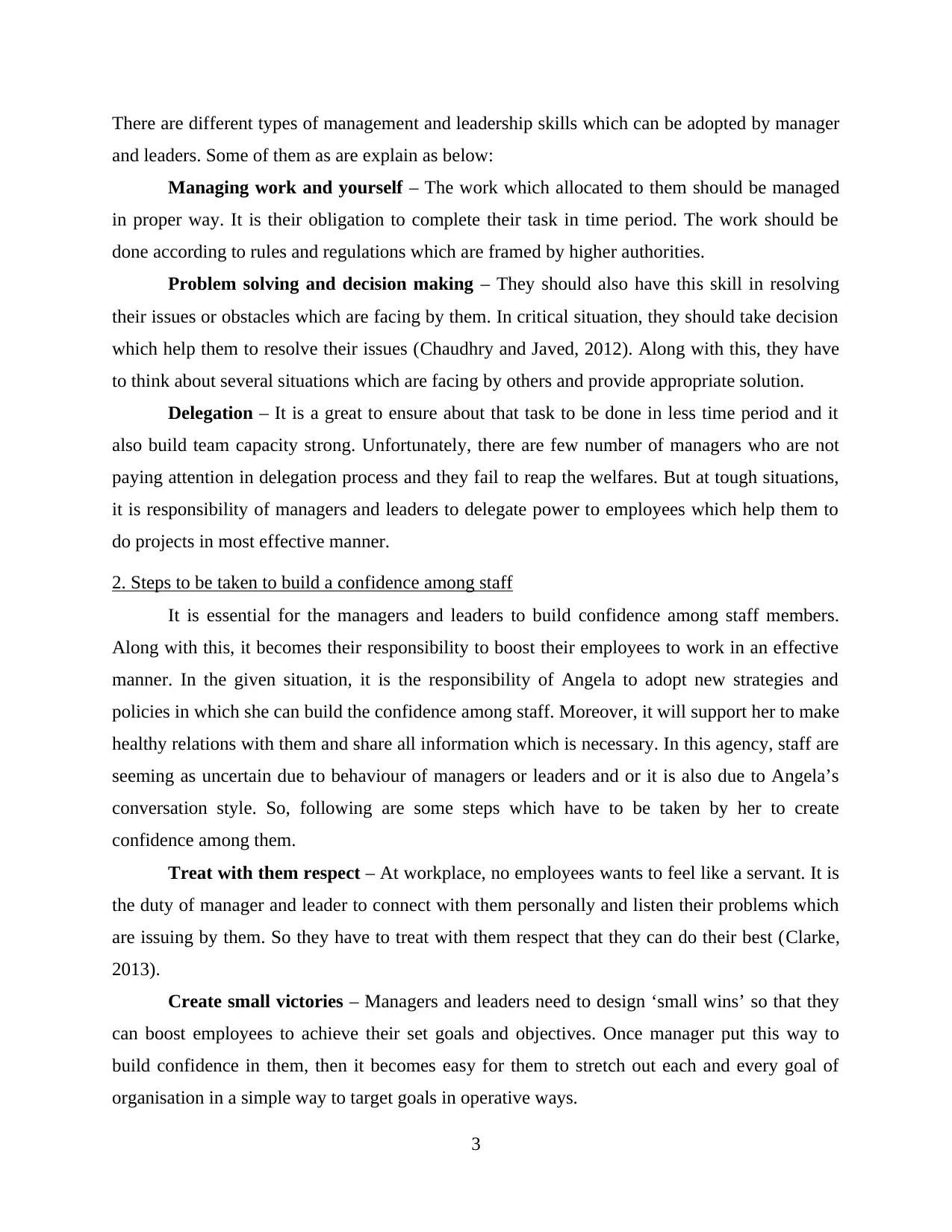
There are different types of management and leadership skills which can be adopted by manager
and leaders. Some of them as are explain as below:
Managing work and yourself – The work which allocated to them should be managed
in proper way. It is their obligation to complete their task in time period. The work should be
done according to rules and regulations which are framed by higher authorities.
Problem solving and decision making – They should also have this skill in resolving
their issues or obstacles which are facing by them. In critical situation, they should take decision
which help them to resolve their issues (Chaudhry and Javed, 2012). Along with this, they have
to think about several situations which are facing by others and provide appropriate solution.
Delegation – It is a great to ensure about that task to be done in less time period and it
also build team capacity strong. Unfortunately, there are few number of managers who are not
paying attention in delegation process and they fail to reap the welfares. But at tough situations,
it is responsibility of managers and leaders to delegate power to employees which help them to
do projects in most effective manner.
2. Steps to be taken to build a confidence among staff
It is essential for the managers and leaders to build confidence among staff members.
Along with this, it becomes their responsibility to boost their employees to work in an effective
manner. In the given situation, it is the responsibility of Angela to adopt new strategies and
policies in which she can build the confidence among staff. Moreover, it will support her to make
healthy relations with them and share all information which is necessary. In this agency, staff are
seeming as uncertain due to behaviour of managers or leaders and or it is also due to Angela’s
conversation style. So, following are some steps which have to be taken by her to create
confidence among them.
Treat with them respect – At workplace, no employees wants to feel like a servant. It is
the duty of manager and leader to connect with them personally and listen their problems which
are issuing by them. So they have to treat with them respect that they can do their best (Clarke,
2013).
Create small victories – Managers and leaders need to design ‘small wins’ so that they
can boost employees to achieve their set goals and objectives. Once manager put this way to
build confidence in them, then it becomes easy for them to stretch out each and every goal of
organisation in a simple way to target goals in operative ways.
3
and leaders. Some of them as are explain as below:
Managing work and yourself – The work which allocated to them should be managed
in proper way. It is their obligation to complete their task in time period. The work should be
done according to rules and regulations which are framed by higher authorities.
Problem solving and decision making – They should also have this skill in resolving
their issues or obstacles which are facing by them. In critical situation, they should take decision
which help them to resolve their issues (Chaudhry and Javed, 2012). Along with this, they have
to think about several situations which are facing by others and provide appropriate solution.
Delegation – It is a great to ensure about that task to be done in less time period and it
also build team capacity strong. Unfortunately, there are few number of managers who are not
paying attention in delegation process and they fail to reap the welfares. But at tough situations,
it is responsibility of managers and leaders to delegate power to employees which help them to
do projects in most effective manner.
2. Steps to be taken to build a confidence among staff
It is essential for the managers and leaders to build confidence among staff members.
Along with this, it becomes their responsibility to boost their employees to work in an effective
manner. In the given situation, it is the responsibility of Angela to adopt new strategies and
policies in which she can build the confidence among staff. Moreover, it will support her to make
healthy relations with them and share all information which is necessary. In this agency, staff are
seeming as uncertain due to behaviour of managers or leaders and or it is also due to Angela’s
conversation style. So, following are some steps which have to be taken by her to create
confidence among them.
Treat with them respect – At workplace, no employees wants to feel like a servant. It is
the duty of manager and leader to connect with them personally and listen their problems which
are issuing by them. So they have to treat with them respect that they can do their best (Clarke,
2013).
Create small victories – Managers and leaders need to design ‘small wins’ so that they
can boost employees to achieve their set goals and objectives. Once manager put this way to
build confidence in them, then it becomes easy for them to stretch out each and every goal of
organisation in a simple way to target goals in operative ways.
3
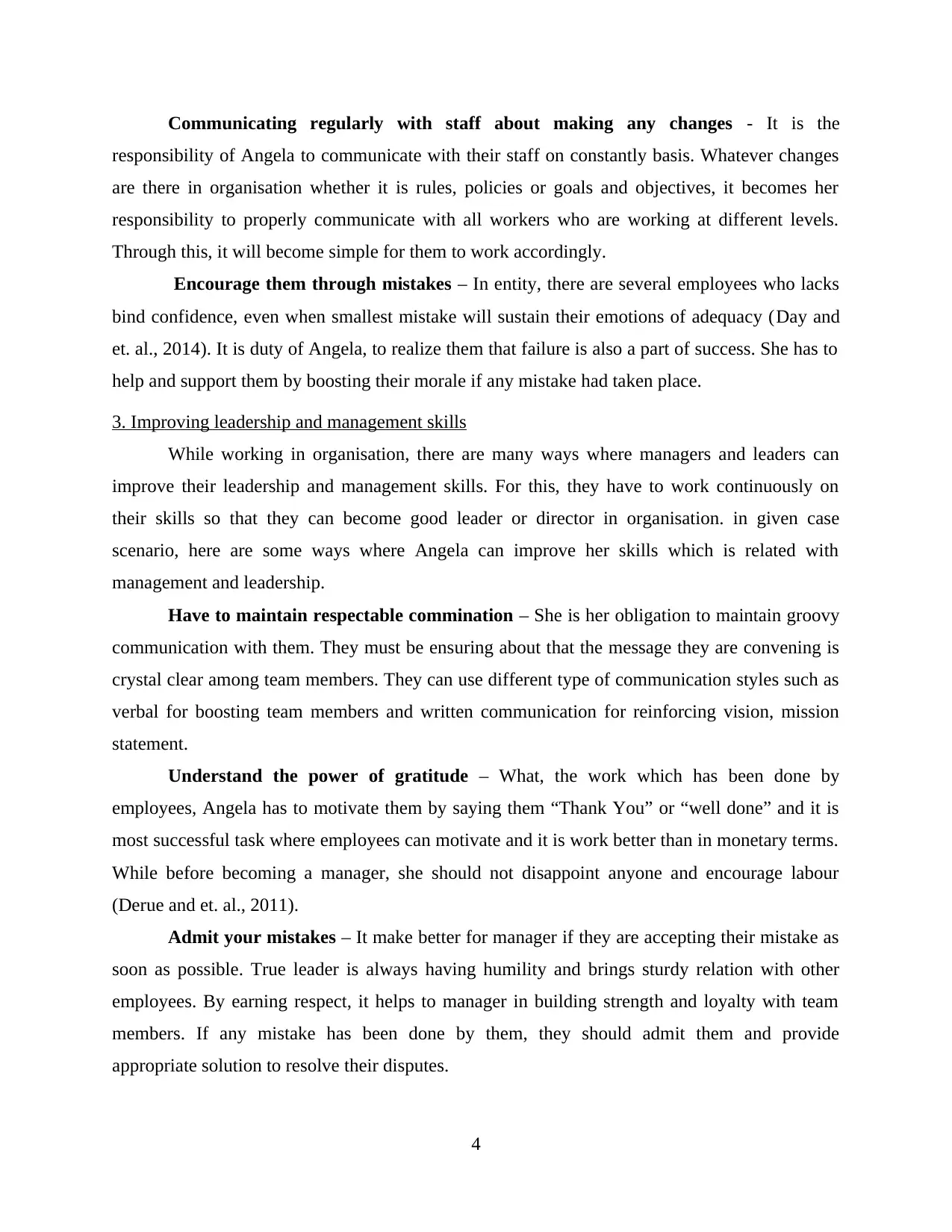
Communicating regularly with staff about making any changes - It is the
responsibility of Angela to communicate with their staff on constantly basis. Whatever changes
are there in organisation whether it is rules, policies or goals and objectives, it becomes her
responsibility to properly communicate with all workers who are working at different levels.
Through this, it will become simple for them to work accordingly.
Encourage them through mistakes – In entity, there are several employees who lacks
bind confidence, even when smallest mistake will sustain their emotions of adequacy (Day and
et. al., 2014). It is duty of Angela, to realize them that failure is also a part of success. She has to
help and support them by boosting their morale if any mistake had taken place.
3. Improving leadership and management skills
While working in organisation, there are many ways where managers and leaders can
improve their leadership and management skills. For this, they have to work continuously on
their skills so that they can become good leader or director in organisation. in given case
scenario, here are some ways where Angela can improve her skills which is related with
management and leadership.
Have to maintain respectable commination – She is her obligation to maintain groovy
communication with them. They must be ensuring about that the message they are convening is
crystal clear among team members. They can use different type of communication styles such as
verbal for boosting team members and written communication for reinforcing vision, mission
statement.
Understand the power of gratitude – What, the work which has been done by
employees, Angela has to motivate them by saying them “Thank You” or “well done” and it is
most successful task where employees can motivate and it is work better than in monetary terms.
While before becoming a manager, she should not disappoint anyone and encourage labour
(Derue and et. al., 2011).
Admit your mistakes – It make better for manager if they are accepting their mistake as
soon as possible. True leader is always having humility and brings sturdy relation with other
employees. By earning respect, it helps to manager in building strength and loyalty with team
members. If any mistake has been done by them, they should admit them and provide
appropriate solution to resolve their disputes.
4
responsibility of Angela to communicate with their staff on constantly basis. Whatever changes
are there in organisation whether it is rules, policies or goals and objectives, it becomes her
responsibility to properly communicate with all workers who are working at different levels.
Through this, it will become simple for them to work accordingly.
Encourage them through mistakes – In entity, there are several employees who lacks
bind confidence, even when smallest mistake will sustain their emotions of adequacy (Day and
et. al., 2014). It is duty of Angela, to realize them that failure is also a part of success. She has to
help and support them by boosting their morale if any mistake had taken place.
3. Improving leadership and management skills
While working in organisation, there are many ways where managers and leaders can
improve their leadership and management skills. For this, they have to work continuously on
their skills so that they can become good leader or director in organisation. in given case
scenario, here are some ways where Angela can improve her skills which is related with
management and leadership.
Have to maintain respectable commination – She is her obligation to maintain groovy
communication with them. They must be ensuring about that the message they are convening is
crystal clear among team members. They can use different type of communication styles such as
verbal for boosting team members and written communication for reinforcing vision, mission
statement.
Understand the power of gratitude – What, the work which has been done by
employees, Angela has to motivate them by saying them “Thank You” or “well done” and it is
most successful task where employees can motivate and it is work better than in monetary terms.
While before becoming a manager, she should not disappoint anyone and encourage labour
(Derue and et. al., 2011).
Admit your mistakes – It make better for manager if they are accepting their mistake as
soon as possible. True leader is always having humility and brings sturdy relation with other
employees. By earning respect, it helps to manager in building strength and loyalty with team
members. If any mistake has been done by them, they should admit them and provide
appropriate solution to resolve their disputes.
4
⊘ This is a preview!⊘
Do you want full access?
Subscribe today to unlock all pages.

Trusted by 1+ million students worldwide
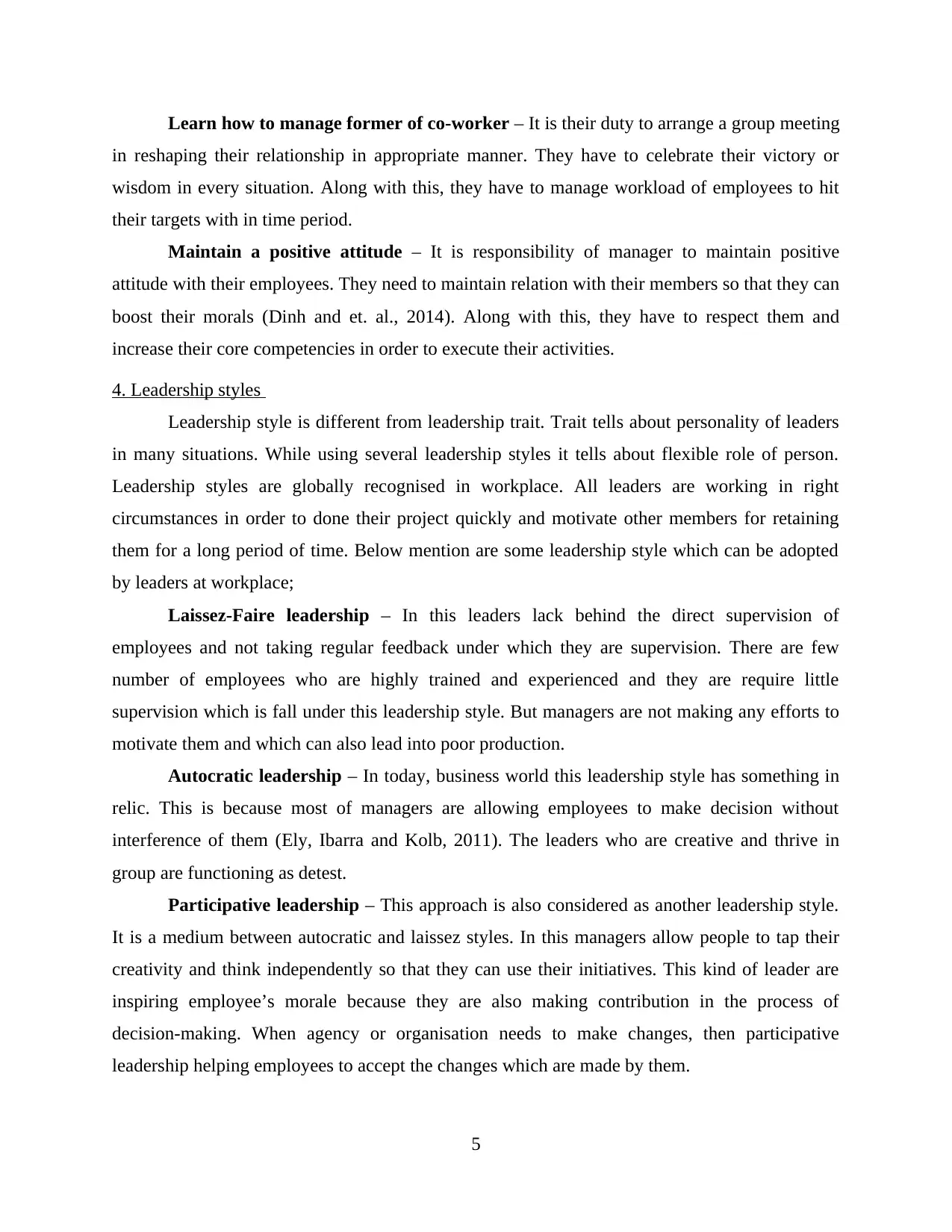
Learn how to manage former of co-worker – It is their duty to arrange a group meeting
in reshaping their relationship in appropriate manner. They have to celebrate their victory or
wisdom in every situation. Along with this, they have to manage workload of employees to hit
their targets with in time period.
Maintain a positive attitude – It is responsibility of manager to maintain positive
attitude with their employees. They need to maintain relation with their members so that they can
boost their morals (Dinh and et. al., 2014). Along with this, they have to respect them and
increase their core competencies in order to execute their activities.
4. Leadership styles
Leadership style is different from leadership trait. Trait tells about personality of leaders
in many situations. While using several leadership styles it tells about flexible role of person.
Leadership styles are globally recognised in workplace. All leaders are working in right
circumstances in order to done their project quickly and motivate other members for retaining
them for a long period of time. Below mention are some leadership style which can be adopted
by leaders at workplace;
Laissez-Faire leadership – In this leaders lack behind the direct supervision of
employees and not taking regular feedback under which they are supervision. There are few
number of employees who are highly trained and experienced and they are require little
supervision which is fall under this leadership style. But managers are not making any efforts to
motivate them and which can also lead into poor production.
Autocratic leadership – In today, business world this leadership style has something in
relic. This is because most of managers are allowing employees to make decision without
interference of them (Ely, Ibarra and Kolb, 2011). The leaders who are creative and thrive in
group are functioning as detest.
Participative leadership – This approach is also considered as another leadership style.
It is a medium between autocratic and laissez styles. In this managers allow people to tap their
creativity and think independently so that they can use their initiatives. This kind of leader are
inspiring employee’s morale because they are also making contribution in the process of
decision-making. When agency or organisation needs to make changes, then participative
leadership helping employees to accept the changes which are made by them.
5
in reshaping their relationship in appropriate manner. They have to celebrate their victory or
wisdom in every situation. Along with this, they have to manage workload of employees to hit
their targets with in time period.
Maintain a positive attitude – It is responsibility of manager to maintain positive
attitude with their employees. They need to maintain relation with their members so that they can
boost their morals (Dinh and et. al., 2014). Along with this, they have to respect them and
increase their core competencies in order to execute their activities.
4. Leadership styles
Leadership style is different from leadership trait. Trait tells about personality of leaders
in many situations. While using several leadership styles it tells about flexible role of person.
Leadership styles are globally recognised in workplace. All leaders are working in right
circumstances in order to done their project quickly and motivate other members for retaining
them for a long period of time. Below mention are some leadership style which can be adopted
by leaders at workplace;
Laissez-Faire leadership – In this leaders lack behind the direct supervision of
employees and not taking regular feedback under which they are supervision. There are few
number of employees who are highly trained and experienced and they are require little
supervision which is fall under this leadership style. But managers are not making any efforts to
motivate them and which can also lead into poor production.
Autocratic leadership – In today, business world this leadership style has something in
relic. This is because most of managers are allowing employees to make decision without
interference of them (Ely, Ibarra and Kolb, 2011). The leaders who are creative and thrive in
group are functioning as detest.
Participative leadership – This approach is also considered as another leadership style.
It is a medium between autocratic and laissez styles. In this managers allow people to tap their
creativity and think independently so that they can use their initiatives. This kind of leader are
inspiring employee’s morale because they are also making contribution in the process of
decision-making. When agency or organisation needs to make changes, then participative
leadership helping employees to accept the changes which are made by them.
5
Paraphrase This Document
Need a fresh take? Get an instant paraphrase of this document with our AI Paraphraser
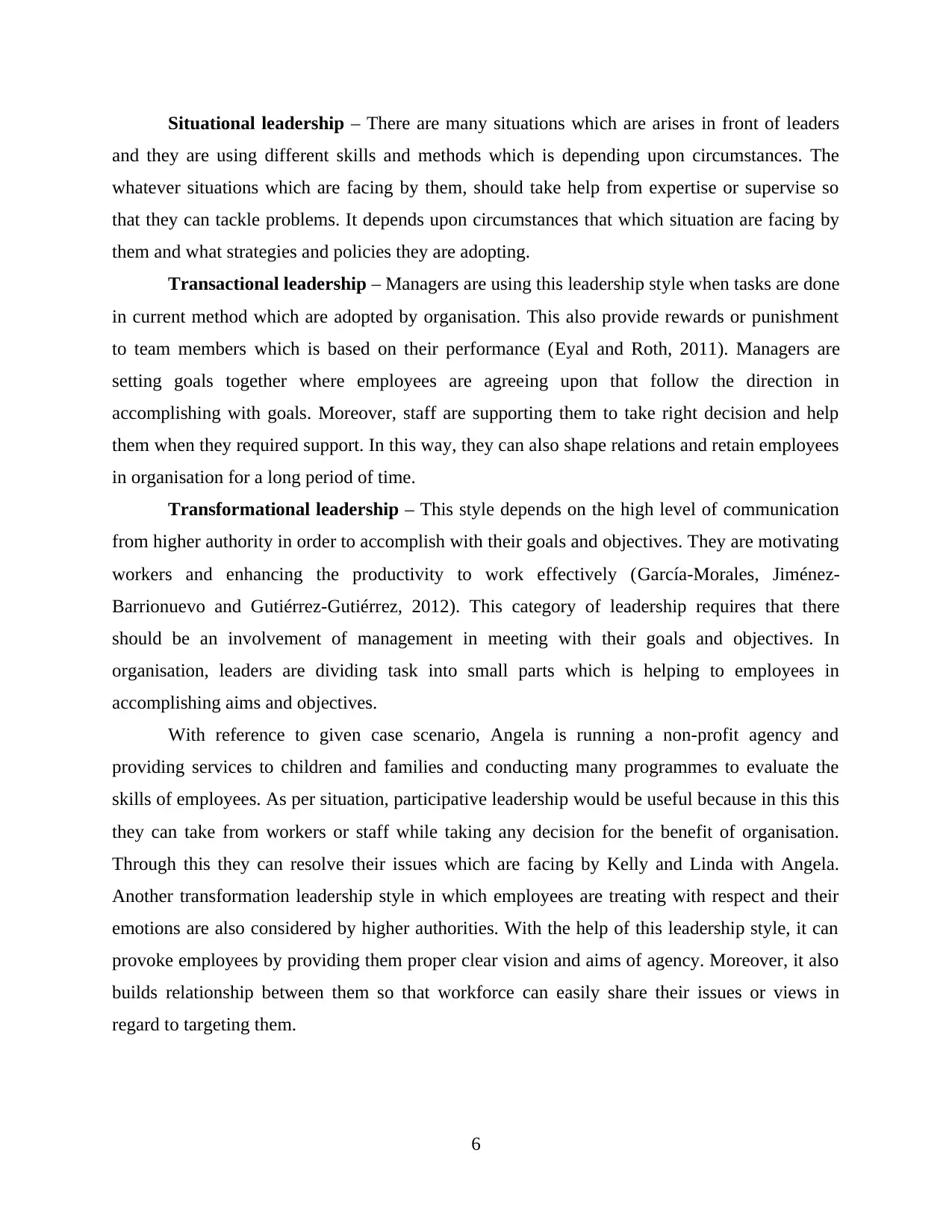
Situational leadership – There are many situations which are arises in front of leaders
and they are using different skills and methods which is depending upon circumstances. The
whatever situations which are facing by them, should take help from expertise or supervise so
that they can tackle problems. It depends upon circumstances that which situation are facing by
them and what strategies and policies they are adopting.
Transactional leadership – Managers are using this leadership style when tasks are done
in current method which are adopted by organisation. This also provide rewards or punishment
to team members which is based on their performance (Eyal and Roth, 2011). Managers are
setting goals together where employees are agreeing upon that follow the direction in
accomplishing with goals. Moreover, staff are supporting them to take right decision and help
them when they required support. In this way, they can also shape relations and retain employees
in organisation for a long period of time.
Transformational leadership – This style depends on the high level of communication
from higher authority in order to accomplish with their goals and objectives. They are motivating
workers and enhancing the productivity to work effectively (García-Morales, Jiménez-
Barrionuevo and Gutiérrez-Gutiérrez, 2012). This category of leadership requires that there
should be an involvement of management in meeting with their goals and objectives. In
organisation, leaders are dividing task into small parts which is helping to employees in
accomplishing aims and objectives.
With reference to given case scenario, Angela is running a non-profit agency and
providing services to children and families and conducting many programmes to evaluate the
skills of employees. As per situation, participative leadership would be useful because in this this
they can take from workers or staff while taking any decision for the benefit of organisation.
Through this they can resolve their issues which are facing by Kelly and Linda with Angela.
Another transformation leadership style in which employees are treating with respect and their
emotions are also considered by higher authorities. With the help of this leadership style, it can
provoke employees by providing them proper clear vision and aims of agency. Moreover, it also
builds relationship between them so that workforce can easily share their issues or views in
regard to targeting them.
6
and they are using different skills and methods which is depending upon circumstances. The
whatever situations which are facing by them, should take help from expertise or supervise so
that they can tackle problems. It depends upon circumstances that which situation are facing by
them and what strategies and policies they are adopting.
Transactional leadership – Managers are using this leadership style when tasks are done
in current method which are adopted by organisation. This also provide rewards or punishment
to team members which is based on their performance (Eyal and Roth, 2011). Managers are
setting goals together where employees are agreeing upon that follow the direction in
accomplishing with goals. Moreover, staff are supporting them to take right decision and help
them when they required support. In this way, they can also shape relations and retain employees
in organisation for a long period of time.
Transformational leadership – This style depends on the high level of communication
from higher authority in order to accomplish with their goals and objectives. They are motivating
workers and enhancing the productivity to work effectively (García-Morales, Jiménez-
Barrionuevo and Gutiérrez-Gutiérrez, 2012). This category of leadership requires that there
should be an involvement of management in meeting with their goals and objectives. In
organisation, leaders are dividing task into small parts which is helping to employees in
accomplishing aims and objectives.
With reference to given case scenario, Angela is running a non-profit agency and
providing services to children and families and conducting many programmes to evaluate the
skills of employees. As per situation, participative leadership would be useful because in this this
they can take from workers or staff while taking any decision for the benefit of organisation.
Through this they can resolve their issues which are facing by Kelly and Linda with Angela.
Another transformation leadership style in which employees are treating with respect and their
emotions are also considered by higher authorities. With the help of this leadership style, it can
provoke employees by providing them proper clear vision and aims of agency. Moreover, it also
builds relationship between them so that workforce can easily share their issues or views in
regard to targeting them.
6
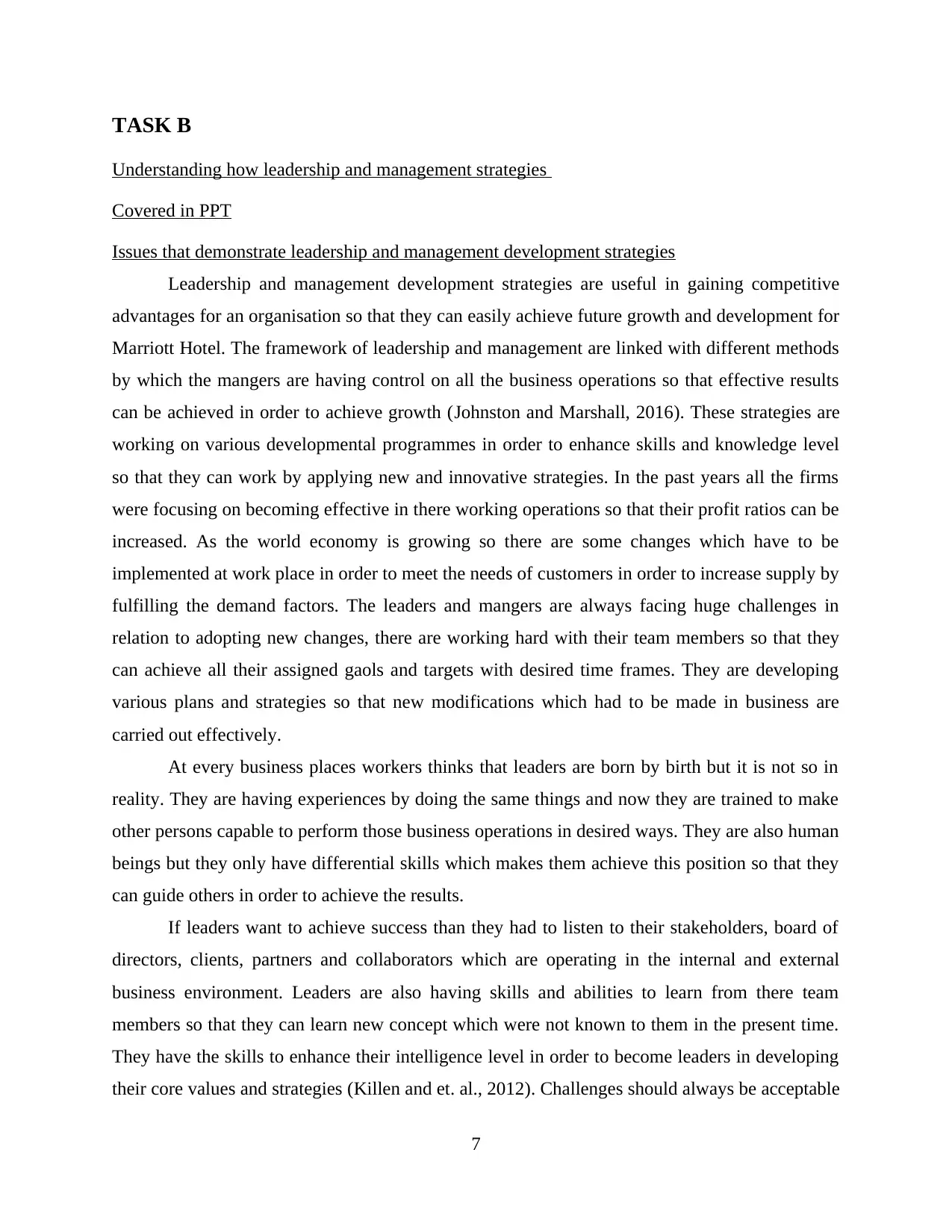
TASK B
Understanding how leadership and management strategies
Covered in PPT
Issues that demonstrate leadership and management development strategies
Leadership and management development strategies are useful in gaining competitive
advantages for an organisation so that they can easily achieve future growth and development for
Marriott Hotel. The framework of leadership and management are linked with different methods
by which the mangers are having control on all the business operations so that effective results
can be achieved in order to achieve growth (Johnston and Marshall, 2016). These strategies are
working on various developmental programmes in order to enhance skills and knowledge level
so that they can work by applying new and innovative strategies. In the past years all the firms
were focusing on becoming effective in there working operations so that their profit ratios can be
increased. As the world economy is growing so there are some changes which have to be
implemented at work place in order to meet the needs of customers in order to increase supply by
fulfilling the demand factors. The leaders and mangers are always facing huge challenges in
relation to adopting new changes, there are working hard with their team members so that they
can achieve all their assigned gaols and targets with desired time frames. They are developing
various plans and strategies so that new modifications which had to be made in business are
carried out effectively.
At every business places workers thinks that leaders are born by birth but it is not so in
reality. They are having experiences by doing the same things and now they are trained to make
other persons capable to perform those business operations in desired ways. They are also human
beings but they only have differential skills which makes them achieve this position so that they
can guide others in order to achieve the results.
If leaders want to achieve success than they had to listen to their stakeholders, board of
directors, clients, partners and collaborators which are operating in the internal and external
business environment. Leaders are also having skills and abilities to learn from there team
members so that they can learn new concept which were not known to them in the present time.
They have the skills to enhance their intelligence level in order to become leaders in developing
their core values and strategies (Killen and et. al., 2012). Challenges should always be acceptable
7
Understanding how leadership and management strategies
Covered in PPT
Issues that demonstrate leadership and management development strategies
Leadership and management development strategies are useful in gaining competitive
advantages for an organisation so that they can easily achieve future growth and development for
Marriott Hotel. The framework of leadership and management are linked with different methods
by which the mangers are having control on all the business operations so that effective results
can be achieved in order to achieve growth (Johnston and Marshall, 2016). These strategies are
working on various developmental programmes in order to enhance skills and knowledge level
so that they can work by applying new and innovative strategies. In the past years all the firms
were focusing on becoming effective in there working operations so that their profit ratios can be
increased. As the world economy is growing so there are some changes which have to be
implemented at work place in order to meet the needs of customers in order to increase supply by
fulfilling the demand factors. The leaders and mangers are always facing huge challenges in
relation to adopting new changes, there are working hard with their team members so that they
can achieve all their assigned gaols and targets with desired time frames. They are developing
various plans and strategies so that new modifications which had to be made in business are
carried out effectively.
At every business places workers thinks that leaders are born by birth but it is not so in
reality. They are having experiences by doing the same things and now they are trained to make
other persons capable to perform those business operations in desired ways. They are also human
beings but they only have differential skills which makes them achieve this position so that they
can guide others in order to achieve the results.
If leaders want to achieve success than they had to listen to their stakeholders, board of
directors, clients, partners and collaborators which are operating in the internal and external
business environment. Leaders are also having skills and abilities to learn from there team
members so that they can learn new concept which were not known to them in the present time.
They have the skills to enhance their intelligence level in order to become leaders in developing
their core values and strategies (Killen and et. al., 2012). Challenges should always be acceptable
7
⊘ This is a preview!⊘
Do you want full access?
Subscribe today to unlock all pages.

Trusted by 1+ million students worldwide
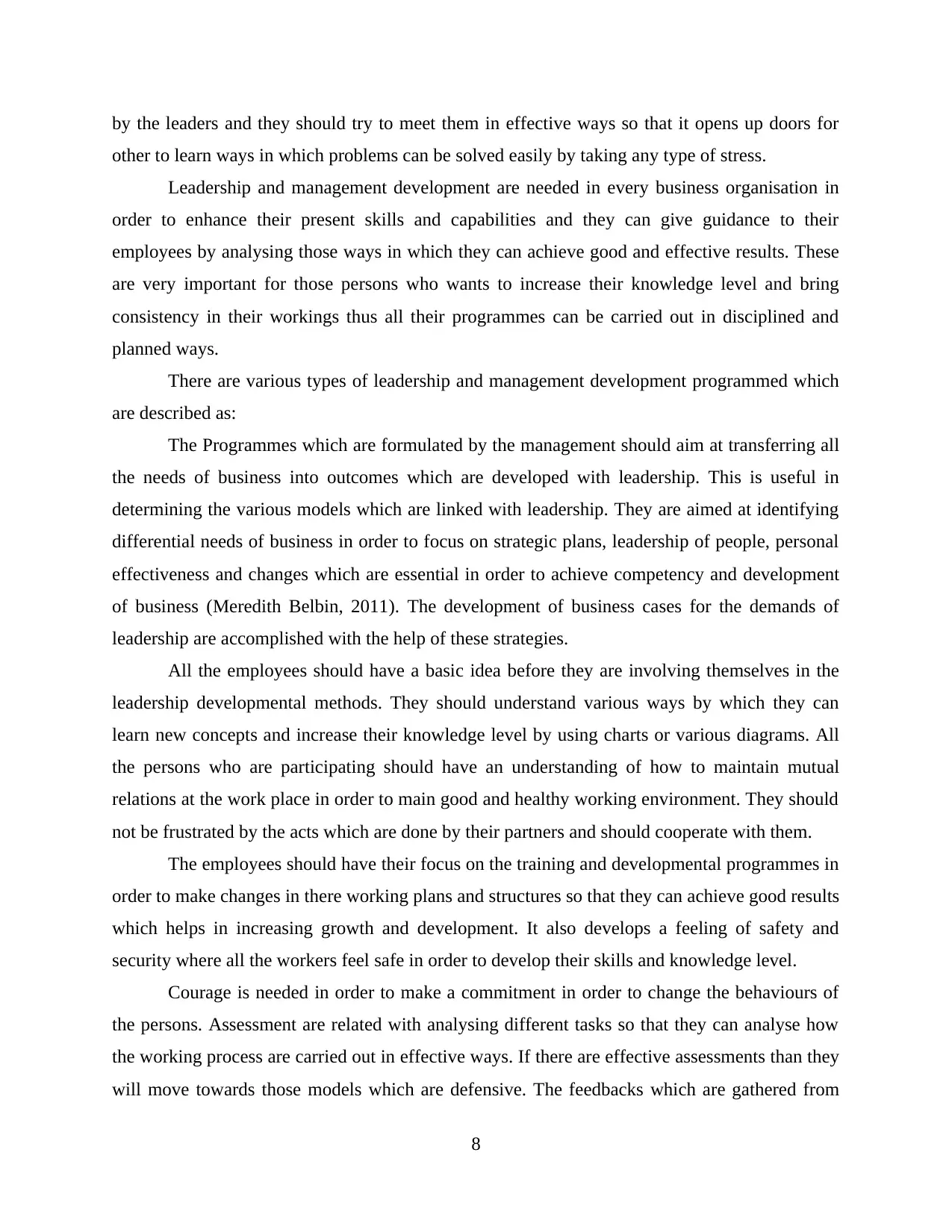
by the leaders and they should try to meet them in effective ways so that it opens up doors for
other to learn ways in which problems can be solved easily by taking any type of stress.
Leadership and management development are needed in every business organisation in
order to enhance their present skills and capabilities and they can give guidance to their
employees by analysing those ways in which they can achieve good and effective results. These
are very important for those persons who wants to increase their knowledge level and bring
consistency in their workings thus all their programmes can be carried out in disciplined and
planned ways.
There are various types of leadership and management development programmed which
are described as:
The Programmes which are formulated by the management should aim at transferring all
the needs of business into outcomes which are developed with leadership. This is useful in
determining the various models which are linked with leadership. They are aimed at identifying
differential needs of business in order to focus on strategic plans, leadership of people, personal
effectiveness and changes which are essential in order to achieve competency and development
of business (Meredith Belbin, 2011). The development of business cases for the demands of
leadership are accomplished with the help of these strategies.
All the employees should have a basic idea before they are involving themselves in the
leadership developmental methods. They should understand various ways by which they can
learn new concepts and increase their knowledge level by using charts or various diagrams. All
the persons who are participating should have an understanding of how to maintain mutual
relations at the work place in order to main good and healthy working environment. They should
not be frustrated by the acts which are done by their partners and should cooperate with them.
The employees should have their focus on the training and developmental programmes in
order to make changes in there working plans and structures so that they can achieve good results
which helps in increasing growth and development. It also develops a feeling of safety and
security where all the workers feel safe in order to develop their skills and knowledge level.
Courage is needed in order to make a commitment in order to change the behaviours of
the persons. Assessment are related with analysing different tasks so that they can analyse how
the working process are carried out in effective ways. If there are effective assessments than they
will move towards those models which are defensive. The feedbacks which are gathered from
8
other to learn ways in which problems can be solved easily by taking any type of stress.
Leadership and management development are needed in every business organisation in
order to enhance their present skills and capabilities and they can give guidance to their
employees by analysing those ways in which they can achieve good and effective results. These
are very important for those persons who wants to increase their knowledge level and bring
consistency in their workings thus all their programmes can be carried out in disciplined and
planned ways.
There are various types of leadership and management development programmed which
are described as:
The Programmes which are formulated by the management should aim at transferring all
the needs of business into outcomes which are developed with leadership. This is useful in
determining the various models which are linked with leadership. They are aimed at identifying
differential needs of business in order to focus on strategic plans, leadership of people, personal
effectiveness and changes which are essential in order to achieve competency and development
of business (Meredith Belbin, 2011). The development of business cases for the demands of
leadership are accomplished with the help of these strategies.
All the employees should have a basic idea before they are involving themselves in the
leadership developmental methods. They should understand various ways by which they can
learn new concepts and increase their knowledge level by using charts or various diagrams. All
the persons who are participating should have an understanding of how to maintain mutual
relations at the work place in order to main good and healthy working environment. They should
not be frustrated by the acts which are done by their partners and should cooperate with them.
The employees should have their focus on the training and developmental programmes in
order to make changes in there working plans and structures so that they can achieve good results
which helps in increasing growth and development. It also develops a feeling of safety and
security where all the workers feel safe in order to develop their skills and knowledge level.
Courage is needed in order to make a commitment in order to change the behaviours of
the persons. Assessment are related with analysing different tasks so that they can analyse how
the working process are carried out in effective ways. If there are effective assessments than they
will move towards those models which are defensive. The feedbacks which are gathered from
8
Paraphrase This Document
Need a fresh take? Get an instant paraphrase of this document with our AI Paraphraser

clients are helpful in analysing the awareness which have been created with the help of these
programmes (Obiwuru and et. al., 2011). This is also beneficial for them in order to achieve the
competitive advantages so that they can achieve success in long run business operations.
The environment of the workplace should be flexible in order to make the employees
work with their full potential and capacities so that they can achieve their desired goals in
particular time frames.
If the management ensures that good and valuable programmes has been adopted at the
work place so that growth can be achieved to all the individuals who are involved in performing
business operations. If there is development than all the long terms goals are achieved at work
places so that personal learning can be achieved in order to evaluate their strengths and
capabilities to achieve the goals and objectives.
Competitive Advantages: These advantages are related with producing goods and
services which are very different in order to achieve strengths at business places. This is
beneficial in increasing their sales ratios by implementing various strategies like lower prices of
products, maintaining the quality aspects than those which are adopted by their competitors.
These are related with different elements like distribution networks, support of the members at
business places. These are helpful in making their products look different from other in order to
gain competitive advantages (Vaccaro and et. al., 2012). This is valuable in achieving high
profits so that they can position themselves at good places and customers can easily differentiate
their goods from others. This results in no threats from the substitute products which are
available in the economy as it will not affect their production and growth factors.
Issues in Leadership and Management Development Strategies
There are various issues which are faced by the leaders and mangers in the most dynamic
and the ever changing environment. There are various challenges which had to achieved by them
in order to perform their business operations in effective and planned ways. The issues which are
faced by them are described as:
Development of managerial effectiveness: It is major issues which are faced at business
places as the employees have to be trained in order to achieve their targets on time, evaluation of
innovative ideas so that they can achieve competitive advantages, participating in the decision
making process in order to achieve best and effective results (Wang and et. al., 2011). This will
help in increasing their work efficiency in order to accomplish growth.
9
programmes (Obiwuru and et. al., 2011). This is also beneficial for them in order to achieve the
competitive advantages so that they can achieve success in long run business operations.
The environment of the workplace should be flexible in order to make the employees
work with their full potential and capacities so that they can achieve their desired goals in
particular time frames.
If the management ensures that good and valuable programmes has been adopted at the
work place so that growth can be achieved to all the individuals who are involved in performing
business operations. If there is development than all the long terms goals are achieved at work
places so that personal learning can be achieved in order to evaluate their strengths and
capabilities to achieve the goals and objectives.
Competitive Advantages: These advantages are related with producing goods and
services which are very different in order to achieve strengths at business places. This is
beneficial in increasing their sales ratios by implementing various strategies like lower prices of
products, maintaining the quality aspects than those which are adopted by their competitors.
These are related with different elements like distribution networks, support of the members at
business places. These are helpful in making their products look different from other in order to
gain competitive advantages (Vaccaro and et. al., 2012). This is valuable in achieving high
profits so that they can position themselves at good places and customers can easily differentiate
their goods from others. This results in no threats from the substitute products which are
available in the economy as it will not affect their production and growth factors.
Issues in Leadership and Management Development Strategies
There are various issues which are faced by the leaders and mangers in the most dynamic
and the ever changing environment. There are various challenges which had to achieved by them
in order to perform their business operations in effective and planned ways. The issues which are
faced by them are described as:
Development of managerial effectiveness: It is major issues which are faced at business
places as the employees have to be trained in order to achieve their targets on time, evaluation of
innovative ideas so that they can achieve competitive advantages, participating in the decision
making process in order to achieve best and effective results (Wang and et. al., 2011). This will
help in increasing their work efficiency in order to accomplish growth.
9
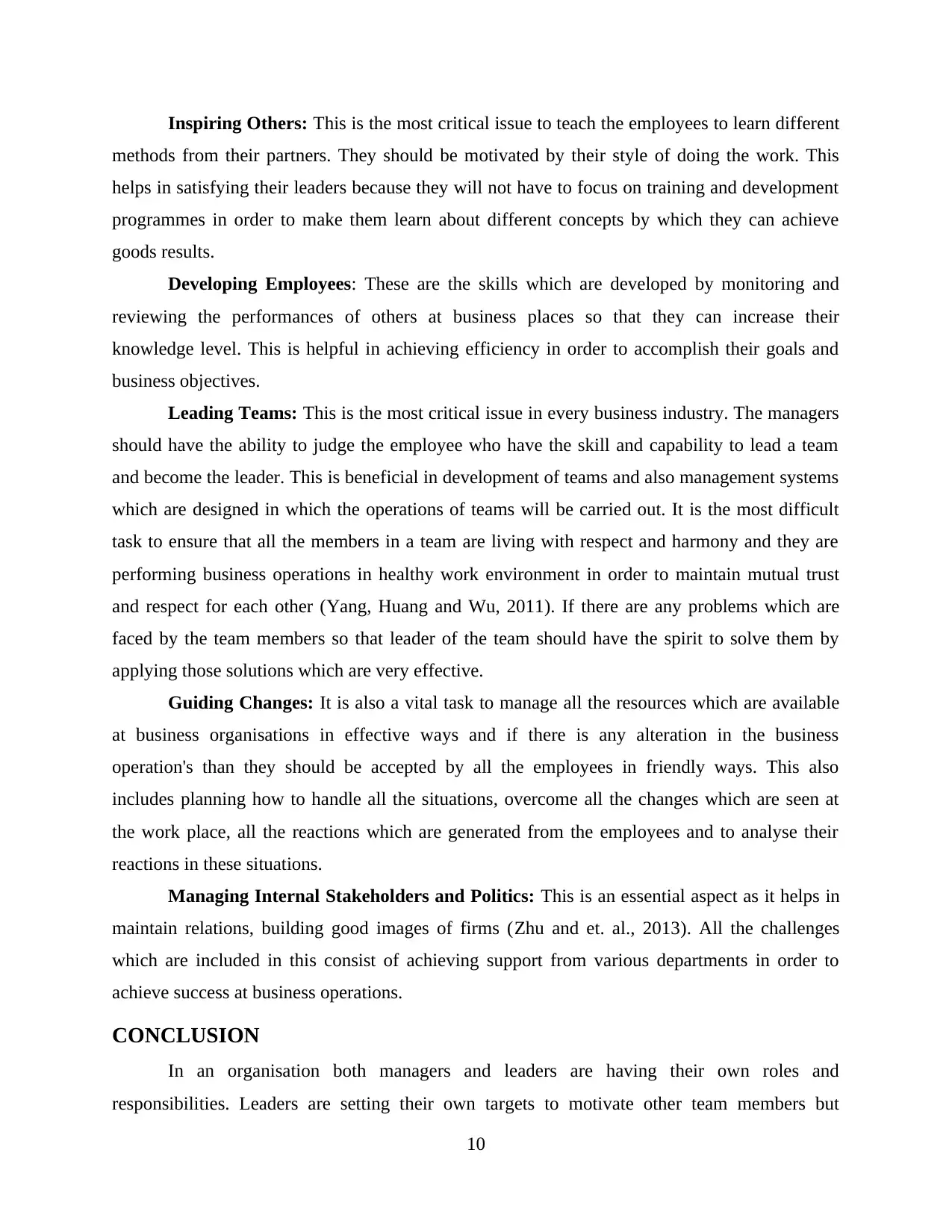
Inspiring Others: This is the most critical issue to teach the employees to learn different
methods from their partners. They should be motivated by their style of doing the work. This
helps in satisfying their leaders because they will not have to focus on training and development
programmes in order to make them learn about different concepts by which they can achieve
goods results.
Developing Employees: These are the skills which are developed by monitoring and
reviewing the performances of others at business places so that they can increase their
knowledge level. This is helpful in achieving efficiency in order to accomplish their goals and
business objectives.
Leading Teams: This is the most critical issue in every business industry. The managers
should have the ability to judge the employee who have the skill and capability to lead a team
and become the leader. This is beneficial in development of teams and also management systems
which are designed in which the operations of teams will be carried out. It is the most difficult
task to ensure that all the members in a team are living with respect and harmony and they are
performing business operations in healthy work environment in order to maintain mutual trust
and respect for each other (Yang, Huang and Wu, 2011). If there are any problems which are
faced by the team members so that leader of the team should have the spirit to solve them by
applying those solutions which are very effective.
Guiding Changes: It is also a vital task to manage all the resources which are available
at business organisations in effective ways and if there is any alteration in the business
operation's than they should be accepted by all the employees in friendly ways. This also
includes planning how to handle all the situations, overcome all the changes which are seen at
the work place, all the reactions which are generated from the employees and to analyse their
reactions in these situations.
Managing Internal Stakeholders and Politics: This is an essential aspect as it helps in
maintain relations, building good images of firms (Zhu and et. al., 2013). All the challenges
which are included in this consist of achieving support from various departments in order to
achieve success at business operations.
CONCLUSION
In an organisation both managers and leaders are having their own roles and
responsibilities. Leaders are setting their own targets to motivate other team members but
10
methods from their partners. They should be motivated by their style of doing the work. This
helps in satisfying their leaders because they will not have to focus on training and development
programmes in order to make them learn about different concepts by which they can achieve
goods results.
Developing Employees: These are the skills which are developed by monitoring and
reviewing the performances of others at business places so that they can increase their
knowledge level. This is helpful in achieving efficiency in order to accomplish their goals and
business objectives.
Leading Teams: This is the most critical issue in every business industry. The managers
should have the ability to judge the employee who have the skill and capability to lead a team
and become the leader. This is beneficial in development of teams and also management systems
which are designed in which the operations of teams will be carried out. It is the most difficult
task to ensure that all the members in a team are living with respect and harmony and they are
performing business operations in healthy work environment in order to maintain mutual trust
and respect for each other (Yang, Huang and Wu, 2011). If there are any problems which are
faced by the team members so that leader of the team should have the spirit to solve them by
applying those solutions which are very effective.
Guiding Changes: It is also a vital task to manage all the resources which are available
at business organisations in effective ways and if there is any alteration in the business
operation's than they should be accepted by all the employees in friendly ways. This also
includes planning how to handle all the situations, overcome all the changes which are seen at
the work place, all the reactions which are generated from the employees and to analyse their
reactions in these situations.
Managing Internal Stakeholders and Politics: This is an essential aspect as it helps in
maintain relations, building good images of firms (Zhu and et. al., 2013). All the challenges
which are included in this consist of achieving support from various departments in order to
achieve success at business operations.
CONCLUSION
In an organisation both managers and leaders are having their own roles and
responsibilities. Leaders are setting their own targets to motivate other team members but
10
⊘ This is a preview!⊘
Do you want full access?
Subscribe today to unlock all pages.

Trusted by 1+ million students worldwide
1 out of 15
Related Documents
Your All-in-One AI-Powered Toolkit for Academic Success.
+13062052269
info@desklib.com
Available 24*7 on WhatsApp / Email
![[object Object]](/_next/static/media/star-bottom.7253800d.svg)
Unlock your academic potential
Copyright © 2020–2025 A2Z Services. All Rights Reserved. Developed and managed by ZUCOL.





